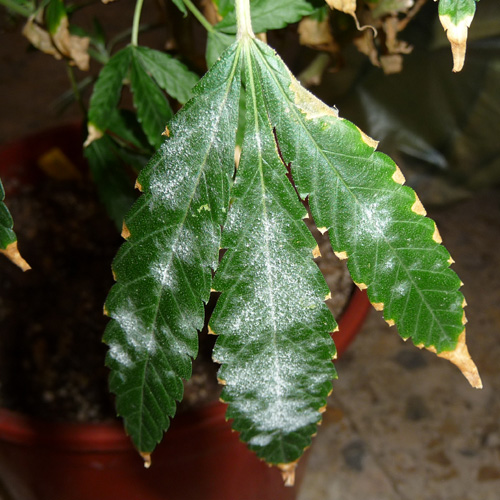
Powdery mildew is the name of a plant disease and the fungus that causes it. It is a parasitical fungus from the Erysiphales family which attacks the above-ground parts of the plant.
Normally most prevalent in the Spring, powdery mildew can strike even in early Autumn. It forms on the surface of leaves, branches or fruit slowly causing necrosis. Then the leaves will start to deform until the plant dries out completely and dies.
This fungus can affect a wide variety of garden plants such as: begonias, chrysanthemums, carnations, roses or dahlias. And also arable plants such as the cucurbitaceous family (melon, water melon, cucumber, pumpkin), vines, peach trees, tomato plants, marihuana, potatoes…
Powdery mildew normally occurs in conditions of high humidity, either due to spray irrigation or prolonged rain with temperatures between 10º-20ºC. It spreads rapidly as its spores are spread by the wind and it’s difficult to eradicate.
You could try treating it with fungicides as a preventive measure but once it strikes, there’s not much you can do.

Other contributory factors include too much shade, poor species selection, excessively dense foliage with poor ventilation, pruning and failing to treat the resulting damage, a combination of high humidity and temperature levels, or poor plant genetics. Another possible cause may be high nitrogen levels due to overfeeding, forcing the plant to absorb more water than normal.
One of the problems with powdery mildew is that when we see the first symptoms, the plant has actually been affected for some time. The first signs to look out for are the formation of small white patches that look like powder or ash. It’s easier to recognise it during the growth phase while during flowering, we shouldn’t mistake trichomes on the buds and nearby leaves for the white powder that identifies powdery mildew.
It’s important to to spot it in time as it’s known that consumption is not at all recommended as it may cause allergies, irritation in the respiratory system and even pulmonary edemas if consumed for long periods.
“Powdery mildew is a particularly ingenious attacker as it can reprogramme the cells so that these adapt their structure and metabolism to accommodate the fungus” explains Professor Ralph Hückelhoven, Director of Phytopathology at Munich’s Technical University (TUM, Germany). « As a consequence, the plant actively promotes the internal growth of the harmful fungus and even supplies it with nutrients ».

How can it be prevented?
As a preventive measure during the growth phase we recommend propolis sprayed on once followed by a second foliar feed ten days later.
Propolis is made by bees from substances they collect from trees, bushes and other plants. Propolis is used by bees to cover small cracks in the hive to prevent bacteria, parasites and other diseases from getting in and is very effective in combating powdery mildew. It also has proven healing properties.
Spray your plants with garlic tea (around 50g of garlic per litre of water). The bactericidal properties of garlic make it a natural and ecological fungicide to treat powdery mildew.
Treating your plants with horsetail is another option for treating powdery mildew either as a preventive measure or as a shock treatment. Horsetail has natural fungicidal properties that make it an effective and ecological fungicide for treating powdery mildew.

The use of mycorrhizas funghi is a good way to help the roots and the plant to grow strongly and able to defend itself better from pests and funghi.
Here are some extra tips on how to control the fungus if growing indoors. Place filters or felt at the opening of the intake fan to prevent it getting in from outside as it spreads through the air. An ozone generator can prevent fungus attacks as these devices have bactericidal, microbicidal, sterilising and deodourising properties. Make sure you use the right mg per m3 according to the size of your indoor garden.
Also, if you make sure to keep your growroom clean and an eye on other plants you have on your patio or garden that may be infected you should be able to enjoy your buds without a visit from this unwelcome guest.




